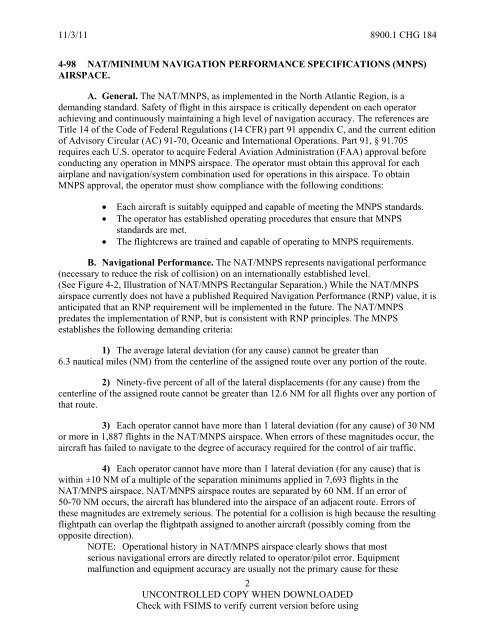Order 8900.1, Volume 4, Chapter 1, Section 5 - Code7700
Order 8900.1, Volume 4, Chapter 1, Section 5 - Code7700
Order 8900.1, Volume 4, Chapter 1, Section 5 - Code7700
You also want an ePaper? Increase the reach of your titles
YUMPU automatically turns print PDFs into web optimized ePapers that Google loves.
11/3/11 <strong>8900.1</strong> CHG 1844-98 NAT/MINIMUM NAVIGATION PERFORMANCE SPECIFICATIONS (MNPS)AIRSPACE.A. General. The NAT/MNPS, as implemented in the North Atlantic Region, is ademanding standard. Safety of flight in this airspace is critically dependent on each operatorachieving and continuously maintaining a high level of navigation accuracy. The references areTitle 14 of the Code of Federal Regulations (14 CFR) part 91 appendix C, and the current editionof Advisory Circular (AC) 91-70, Oceanic and International Operations. Part 91, § 91.705requires each U.S. operator to acquire Federal Aviation Administration (FAA) approval beforeconducting any operation in MNPS airspace. The operator must obtain this approval for eachairplane and navigation/system combination used for operations in this airspace. To obtainMNPS approval, the operator must show compliance with the following conditions:• Each aircraft is suitably equipped and capable of meeting the MNPS standards.• The operator has established operating procedures that ensure that MNPSstandards are met.• The flightcrews are trained and capable of operating to MNPS requirements.B. Navigational Performance. The NAT/MNPS represents navigational performance(necessary to reduce the risk of collision) on an internationally established level.(See Figure 4-2, Illustration of NAT/MNPS Rectangular Separation.) While the NAT/MNPSairspace currently does not have a published Required Navigation Performance (RNP) value, it isanticipated that an RNP requirement will be implemented in the future. The NAT/MNPSpredates the implementation of RNP, but is consistent with RNP principles. The MNPSestablishes the following demanding criteria:1) The average lateral deviation (for any cause) cannot be greater than6.3 nautical miles (NM) from the centerline of the assigned route over any portion of the route.2) Ninety-five percent of all of the lateral displacements (for any cause) from thecenterline of the assigned route cannot be greater than 12.6 NM for all flights over any portion ofthat route.3) Each operator cannot have more than 1 lateral deviation (for any cause) of 30 NMor more in 1,887 flights in the NAT/MNPS airspace. When errors of these magnitudes occur, theaircraft has failed to navigate to the degree of accuracy required for the control of air traffic.4) Each operator cannot have more than 1 lateral deviation (for any cause) that iswithin ±10 NM of a multiple of the separation minimums applied in 7,693 flights in theNAT/MNPS airspace. NAT/MNPS airspace routes are separated by 60 NM. If an error of50-70 NM occurs, the aircraft has blundered into the airspace of an adjacent route. Errors ofthese magnitudes are extremely serious. The potential for a collision is high because the resultingflightpath can overlap the flightpath assigned to another aircraft (possibly coming from theopposite direction).NOTE: Operational history in NAT/MNPS airspace clearly shows that mostserious navigational errors are directly related to operator/pilot error. Equipmentmalfunction and equipment accuracy are usually not the primary cause for these2UNCONTROLLED COPY WHEN DOWNLOADEDCheck with FSIMS to verify current version before using
















